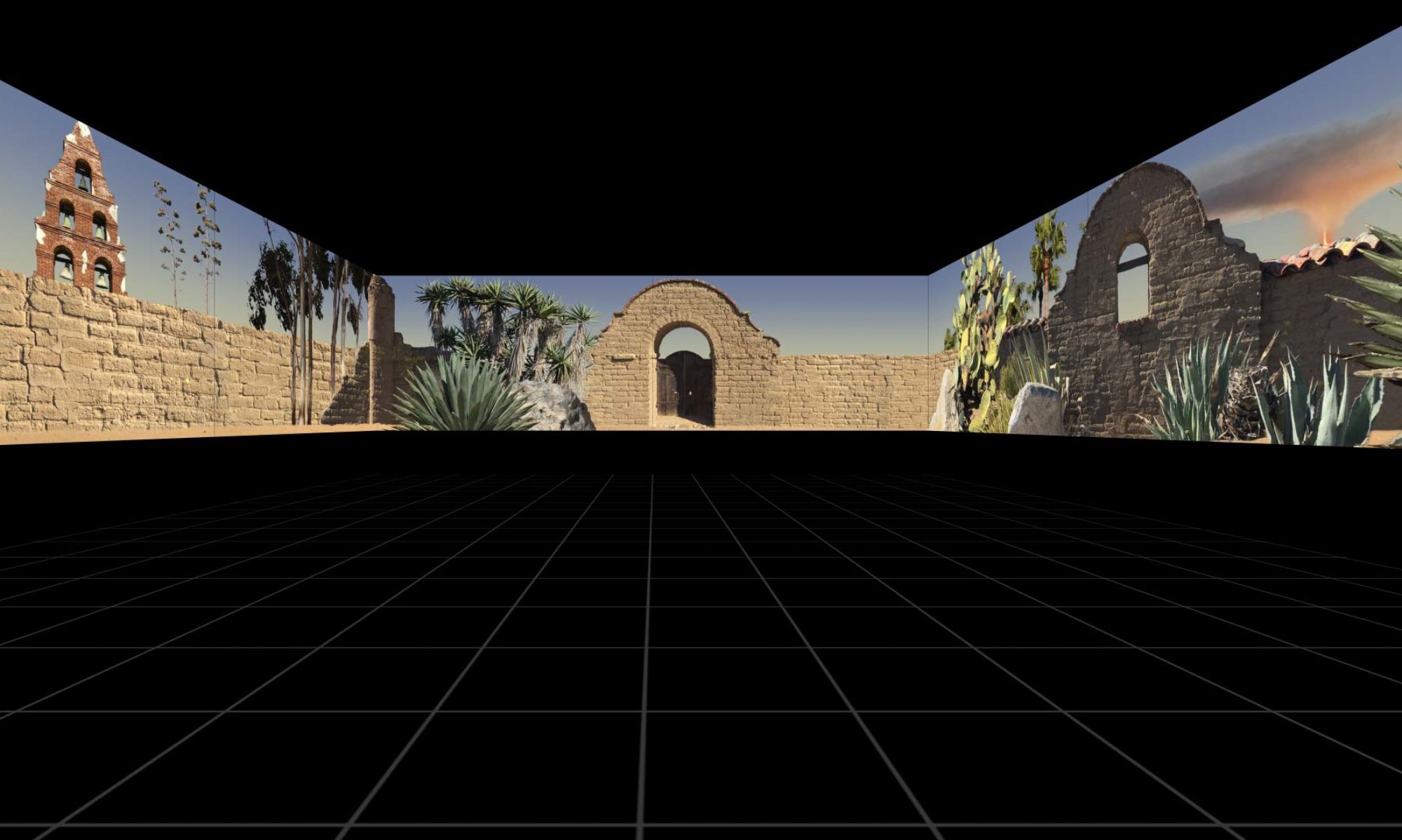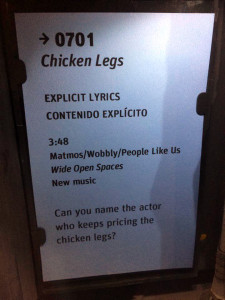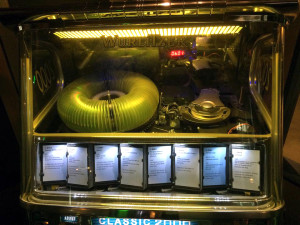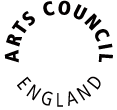Spotted by our friend Jonathan Lemon – a track by People Like Us, Wobbly and Matmos on their jukebox! No idea quite why the song is explicit… the “lyrics” come from a local London commercial radio station advert from the 1990s. Download Wide Open Spaces for free at UbuWeb.
CCCitations – a Citation City project
CCCitations is an offshoot of Citation City, an audiovisual performance by People Like Us.
Four artists, Jon Leidecker, Jason Willett, Gwilly Edmondez and Andrew Sharpley were given source material from Vicki Bennett’s Citation City a/v project and asked to make new work, interpreting the footage in a unique way.
Soundtrack: Gwilly Edmondez 00:01
Soundtrack: Jason Willett 02:47
Soundtrack: Jon Leidecker 05:23
Film: Vicki Bennett
Film and Video: Andrew Sharpley – using source material given by Vicki Bennett
About Citation City
Citation City sources, collage and edits 300 major feature films where content is either filmed or set in London – creating a story within a story, of the film world, living its life, through extraordinary times of change, to see what happens when these multiple narratives are combined… what will the story tell us that one story alone could never tell?
Inspired by The Arcades Project by Walter Benjamin, this audiovisual work is created from 1000s of clippings of text and visual media, collaged using a system of “convolutes”, collated around subjects of key motifs, historical figures, social types, cultural objects from the time. By gathering and assembling such groups of similar yet unrelated, he revealed a hidden, magical encyclopaedia of affinities, a massive and labyrinthine architecture of a collective dream city. On reading Benjamin, his approach to editing astonished Vicki Bennett, and the similarity of their creative processes of cutting and collating extensive lists of subject matter by context.
In the live performance a series of story lines (convolutes) sit side by side with a soundtrack sourced both from the movie content, as well as new sample compositions thematically related to the visual content.
The result is a sweeping panorama of London, a London as represented through cinema – not the real city at all, but one that exists in the collective imagination of moviegoers throughout the decades. Filmmaker Magazine
NOTATIONS UK Tour 2013 Travelogue
Here’s an entertaining, informative (we hope) one-hour video travelogue of our recent Notations Tour.
Featuring performers Bill Orcutt, Rhodri Davies, M.C. Schmidt, Philip Jeck, Jaap Blonk, Steve Noble, Wobbly, Mark Sanders, Tomomi Adachi and Jennifer Walshe. Oh, and People Like Us. Also, tour producers Richard Whitelaw and Lee Etherington make appearances.
http://soundandmusic.org/node/8760
https://peoplelikeus.org/2013/notations-tour/
Leeds NOTATIONS – video excerpts
Thanks to those that attended Leeds NOTATIONS at Hyde Park Picture House as part of Leeds International Film Festival on 16 Nov 2013 – here are two edits with M.C. Schmidt, Tomomi Adachi and Wobbly. Thanks to Tusk and Sound & Music!
NOTATIONS Leeds Hyde Park Picture House w/ M.C. Schmidt, Tomomi Adachi & Wobbly on Vimeo.
NOTATIONS Live at Leeds Hyde Park Picture House w/ M.C. Schmidt, Tomomi Adachi & Wobbly. Film by Vicki Bennett on Vimeo.
Manchester NOTATIONS – video excerpts
Thanks to those that attended Manchester NOTATIONS at Kraak on 14 Nov 2013 – here are two small edits from the evening with M.C. Schmidt, Jennifer Walshe and Wobbly. Thanks to Tusk and Sound & Music!
NOTATIONS TRAILER Manchester w/ M.C. Schmidt / Wobbly / Jennifer Walshe. Film by Vicki Bennett on Vimeo.
Notations Trailer, Manchester with M.C. Schmidt, Jennifer Walshe & Wobbly. Film by Vicki Bennett on Vimeo.
NOTATIONS UK Tour!
NOTATIONS – the film by Vicki Bennett (People Like Us) created for live performance by improvising artists and musicians, will tour the UK in November 2013, produced by Tusk and commissioned by Sound and Music as part of their Touring Programme for 2013.
PRESS RELEASE
Sound And Music and Tusk Music are delighted to announce this tour of Vicki Bennett’s film-collage-as-visual-score Notations, to be soundtracked by a unique combination of leading improvising artists at each event.
Notations has been created by Vicki from hundreds of different film clips, where the content conceptually or literally portrays different kinds of ‘gestures’ or ‘instructions’ to be read by the improvising artists on stage as a visual score.
This marks a return to working with improvised audio and video, both on radio and in front of an audience. Between 1996-2003 Vicki performed both solo and with Jon Leidecker (Wobbly), Matt Wand (Stock, Hausen and Walkman), Matmos, members of Negativland and Kenneth Goldsmith.
To soundtrack Notations, Vicki and Tusk have recruited an impressive international cast of improvisers, each with radically different approaches and, as each show will feature a different combination of artists, every performance on the tour will be completely unique. So each show will feature a carefully chosen trio of live respondents to Notations from the cast of Bill Orcutt, Rhodri Davies, M.C. Schmidt (Matmos), Philip Jeck, Jaap Blonk, Steve Noble, Wobbly, Mark Sanders, Tomomi Adachi and Jennifer Walshe.
Oct 31 – NEWCASTLE
BILL ORCUTT / RHODRI DAVIES / MARK SANDERS
+ BILL ORCUTT SOLO SET
& PEOPLE LIKE US “CONSEQUENCES (ONE THING LEADS TO ANOTHER)”
Star & Shadow Cinema, Stepney Bank, NE1 2NP
8pm £8/10
starandshadow.org.uk
===============
Nov 14 – MANCHESTER
M.C. SCHMIDT / WOBBLY / JENNIFER WALSHE
& PEOPLE LIKE US “CONSEQUENCES (ONE THING LEADS TO ANOTHER)”
Kraak, 11 Stevenson Square, M1 1DB
7.30pm £8/7
kraak.co/home
===============
Nov 16 – LEEDS (as part of Leeds International Film Festival)
M.C. SCHMIDT / WOBBLY / TOMOMI ADACHI
& PEOPLE LIKE US “CONSEQUENCES (ONE THING LEADS TO ANOTHER)”
Hyde Park Picture House, Brudenell Road, LS6 1JD
9pm £8/£6
leedsfilm.com
===============
Nov 29 – LONDON
JAAP BLONK / PHILIP JECK
& PEOPLE LIKE US “CONSEQUENCES (ONE THING LEADS TO ANOTHER)”
Cafe Oto, 18-22 Ashwin Street, London, E8 3DL
8pm £8/10
cafeoto.co.uk
===============
Nov 30 – BRISTOL
JAAP BLONK / PHILIP JECK / STEVE NOBLE
& PEOPLE LIKE US “CONSEQUENCES (ONE THING LEADS TO ANOTHER)”
Arnolfini, 16 Narrow Quay, BS1 4QA
7.30pm £8/6
arnolfini.org.uk
Each event will also begin with an audiovisual performance by People Like Us of Consequences (One Thing Leads To Another), which places similar but emerging subject matter side by side to construct the narrative, a story emerging as a sum of the preceding parts yet digressing on a tangent. All actions have consequences, and here we see them played out, to wondrous and catastrophic effect!
Watch a section from Consequences (One Thing Leads To Another) on UbuWeb!
NOTATIONS TRAILER Manchester w/ M.C. Schmidt / Wobbly / Jennifer Walshe. Film by Vicki Bennett
More info on the artists:
Vicki Bennett is an influential figure in the field of audio visual collage, through her innovative sampling, appropriating and cutting up of found footage and archives. Using collage as her main form of expression, she creates audio recordings, films and radio that communicate a humorous, dark and often surreal view on life. Vicki operates under the moniker People Like Us and promotes an open access to archives for creative use.
Bill Orcutt first came to attention as guitarist in insane Miami band Harry Pussy, famed for their frenetic and discordant performances and his then-wife Adris Hoyo’s seminally fiery primitive/spasmodic drumming. Harry Pussy imploded in the late 90s but Orcutt re-emerged in 2009 with A New Way To Pay Old Debts, a truly guttural home-recorded stream-of-consciousness via battered guitar with only 4 strings left and occasional involuntary vocalisations. Has since released records via Editions Mego as well as his own Palilalia imprint, and formed an occasional duo with Chris Corsano. palilalia.com
Our favourite Rhodri Davies story concerns his being booed off stage for destroying his instrument at a very conservative harp festival. Davies takes this traditional instrument and does very un-traditional things with it, from applying dry ice to the strings to make them squeal to constructing installations that play it with wind and water. Regular collaborators include David Toop, John Tilbury and John Butcher and such luminaries as Elian Radigue, Christian Wolff and Yasunao Tone have composed specifically for him. rhodridavies.com
M.C. Schmidt is best known as one half of Californian (now relocated to Baltimore) duo Matmos, renowned for marrying a love of electronic pop with musique concrete tactics and a penchant for unusual sound sources (liposuction surgery, amplified crayfish nerve tissue, latex fetish clothing, contact mics on human hair…). In 2001 they were invited to work with Bjork on her Vespertine album, leading to two world tours as part of her band, and have also collaborated with Zeena Parkins, Antony, David Tibet, Marina Abramovic and many others. vague-terrain.com
Philip Jeck rescues old records and turntables from junk shops and creates something beautiful from them. He won the 1993 Time Out Performance Award for his most famous work Vinyl Requiem, a performance for 180 vintage record players and has released a series of records on the renowned Touch label and collaborated with Gavin Bryars, Otomo Yoshihide and Jaki Liebezeit, amongst others. philipjeck.com
Jaap Blonk hails from the Netherlands and is a self-taught composer and poet best known for his improvised vocal performances and sound poetry. Blonk is highly regarded for his pure and uninhibited style of improvisation, his sets often given greater depth by the use of live electronics, and he has collaborated with Maja Ratkje, Mats Gustafsson, Joan La Barbara, The Ex and many others. jaapblonk.com
Steve Noble first appeared as part of pop group Rip, Rig And Panic before becoming involved for several years with Derek Bailey’s Company Weeks and becoming over the years a key figure in the UK’s improvised and free music community, playing with improvisers of all approaches including Peter Brotzmann, Stephen O’Malley, John Edwards, Ikue Mori and Keiji Haino.
efi.group.shef.ac.uk/musician/mnoble.html
Wobbly is the nom de plume of Californian plunderphonic artist Jon Leidecker who, like Vicki Bennett, uses found materials and collage as a key part of his working method, so its perhaps inevitable that they have produced several records together. He’s also released a series of records on Important, Illegal Art, Tigerbeat6 and other labels and collaborated with Matmos, Jay Lesser and many others. detritus.net/wobbly
Mark Sanders is a drummer and key part of the UK free music scene with an astounding list of collaborators from Derek Bailey to Okkyung Lee, Charles Gayle and William Parker. Mark has performed all over the world and released over 120 cds and also forms a rhythm section with bassist John Edwards in a number of groups. marksanders.me.uk
Tomomi Adachi is from Kazanawa, Japan and is a composer, sound poet and installation artist, improvising live with the use of voice, live electronics and his own instrument designs. Regarded as Japan’s only sound poet, he gave the first ever Japanese performance of Schwitters’ Ursonate and has performed the works of Cage, Cardew, Wolff and others and collaborated with countless artists including Zbigniew Karkowski, Annette Krebs and Akio Suzuki. adachitomomi.com/n/biography.html
Jennifer Walshe is a renowned vocalist and composer with so many strings to her artistic bow its hardly surprising she was so successful with her Grúpat project, where she adopted and developed 9 separate personas, each with their own individual creative outlet. The project led to exhibitions, photography, sculptures and more internationally by each of the personas. She’s perhaps best known as the composer of the opera XXX_Live_Nude_Girls!!! and is also highly regarded as a vocalist and improviser. cmc.ie/composers/composer.cfm?composerID=114
This tour is produced by Tusk Music in association with Sound And Music.
tuskmusic.co.uk
soundandmusic.org

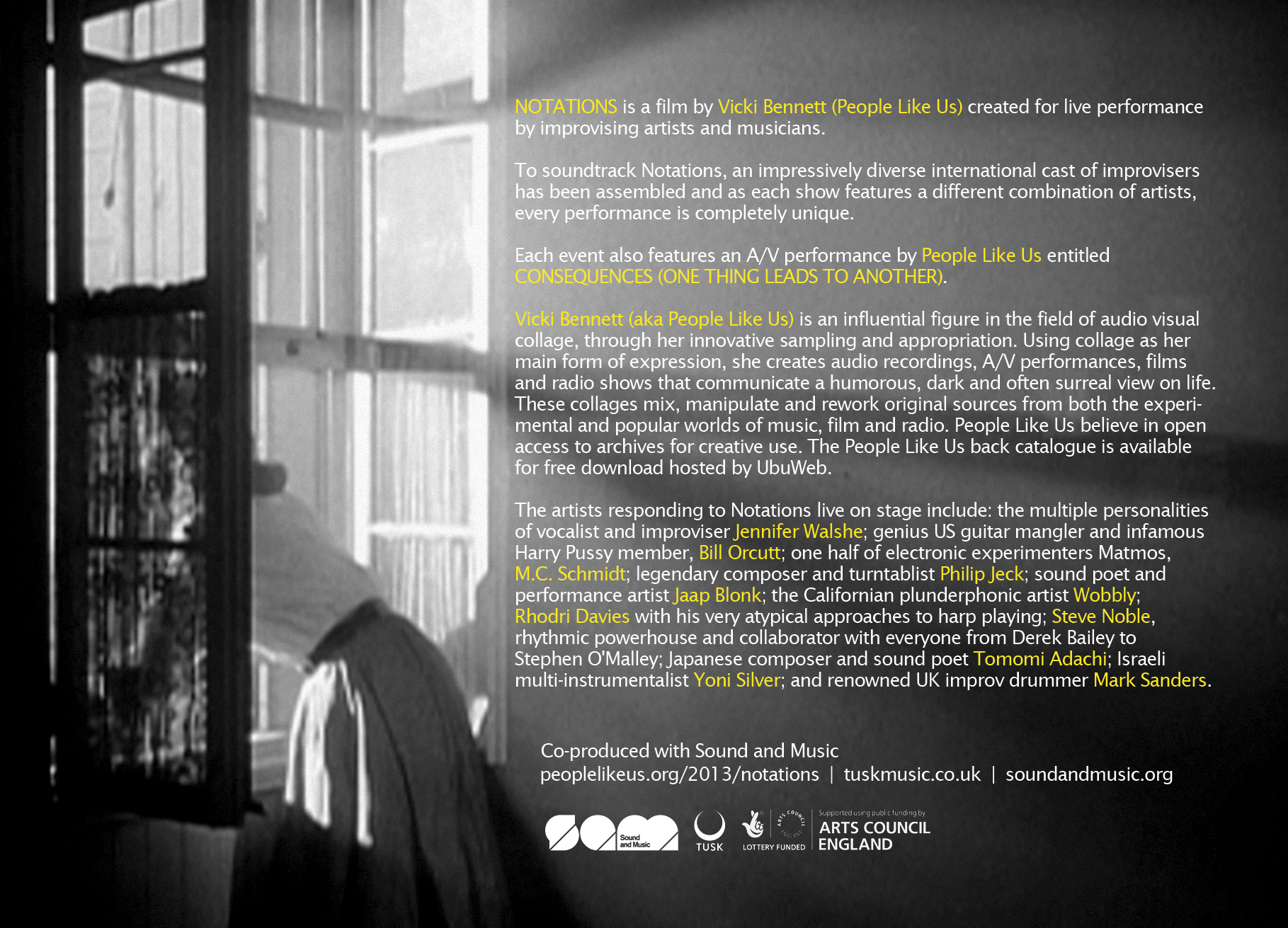
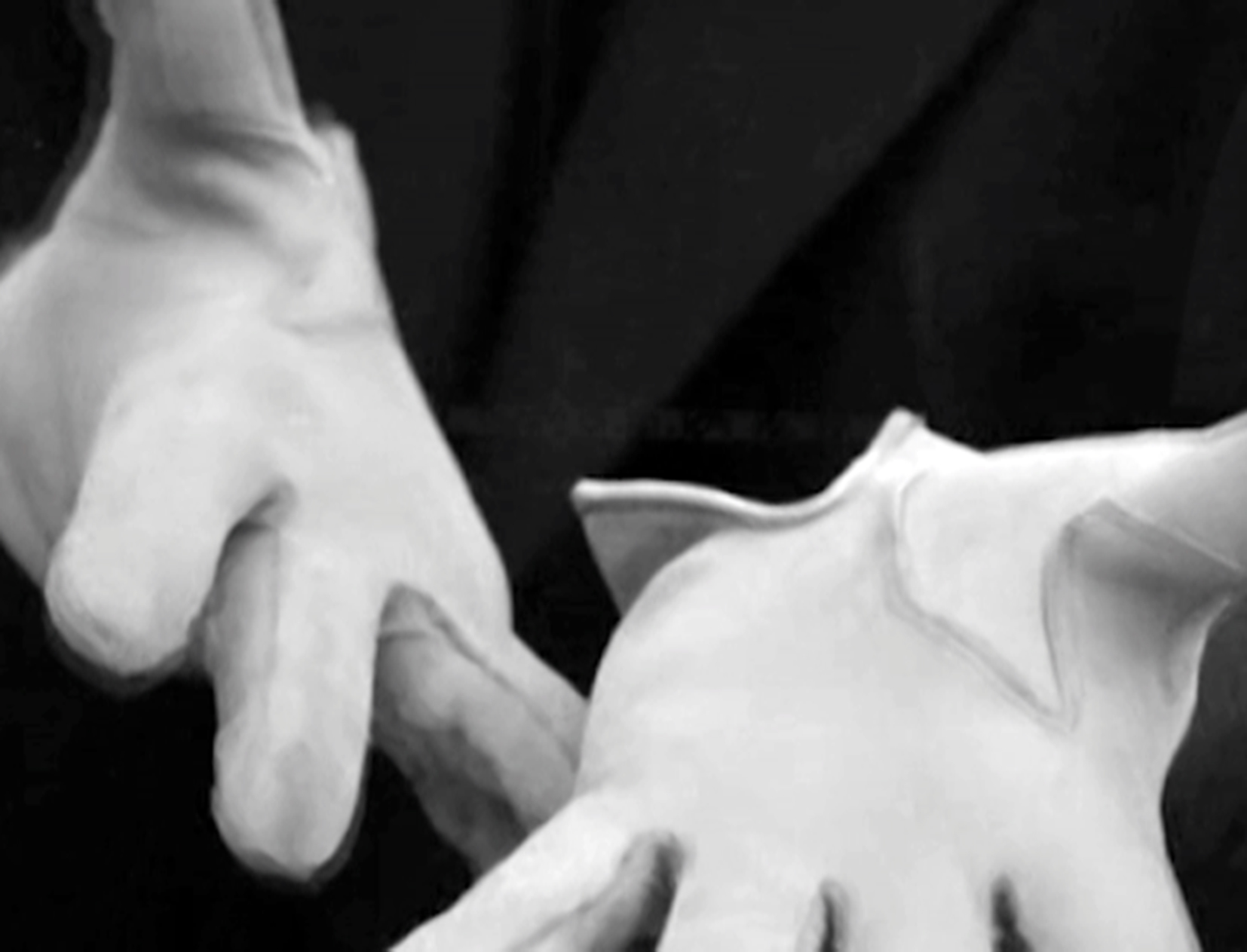

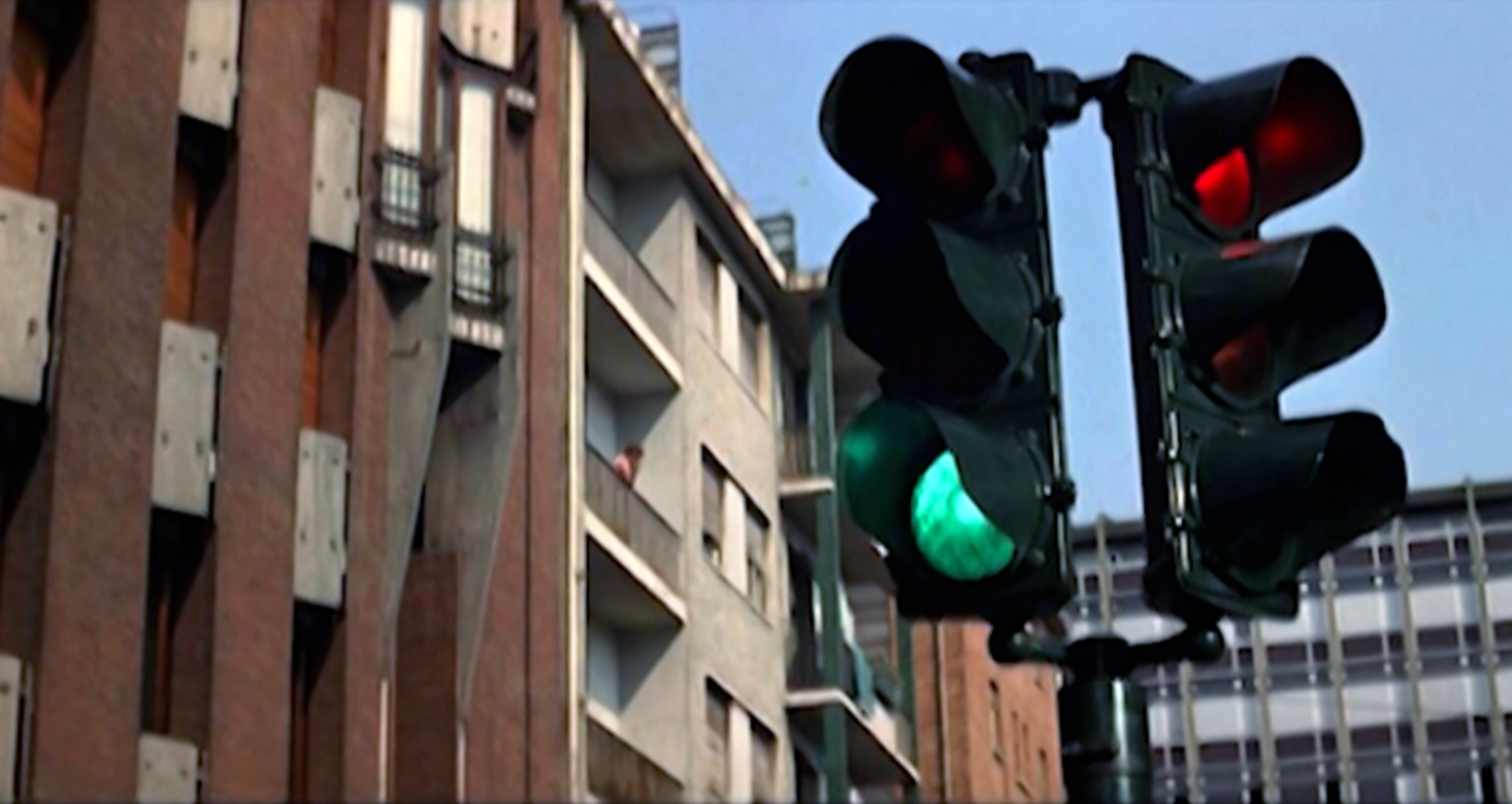
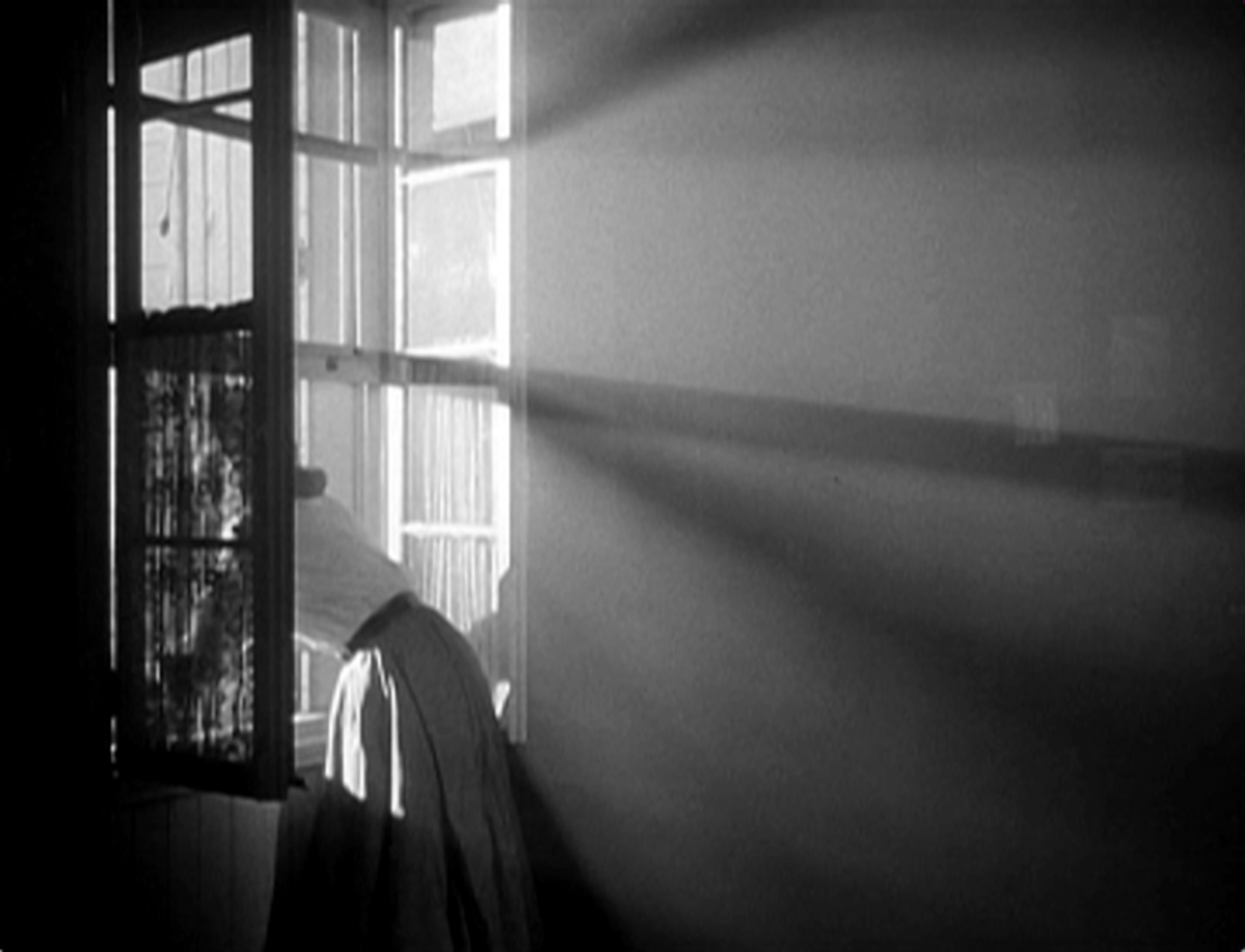
SOCIAL MEDIA FLYERS
Download a zipped file of social media flyers for each concert and the whole tour
INTERVIEWS
Interview with Richard Whitelaw from Sound and Music, October 2013
MORE ABOUT NOTATIONS as a VISUAL SCORE
When performed, the film is provided with a “score” (ie a list of instructions to be translated into sound) which consists of some basic instructions and a synopsis listing characteristics of the 9 different sketches featured in the film. The sketches are as follows:
The film is made in 9 sketches with titles that roughly describe the content/concept/theme. The themes move and progress with many tangents, although there is continuity of concepts and the pace even and flowing. There is intermittent film sound throughout, and lots of silence. Hopefully the sound will be no more surprising than any other performer on the stage. The maximum audio volume should be set equal to each participant.
There will be no instructions to be found beyond what is in the film, no written score beyond this text. The film will be provided to the players at least 2 weeks before the performance date, and should be viewed several times well before performing. For each sketch different numbers and combinations of performers are recommended, either spontaneously or pre-determined. All players should meet to discuss this before performing, and rehearsals are at the discretion of the performers.
Ultimately, whatever the film content suggests is what all should react to. – Vicki Bennett, May 2013
1. A Nod to Previous Players.
Majority of footage sourced from old avant-garde and comedy films featuring people playing cards and chess, also doing things at tables. Very little sound added to the film soundtrack.
2. From A-B.
Transport, trains, cars, carriages and things that move fast. Some typewriting and conducting too. This one is fast and also noisy in places!
3. Spin.
Lots of spinning, vertigo, circles and targets. Zooming into eyes. Camera shutters. Not too much incidental sound on the film apart from towards the end with a piano.
4. At Home.
Mainly footage shot in domestic environments – pans through people’s rooms, people eating and chopping food, ringing doorbells, broken appliances and acts of domestic destruction. Reel to reel tape recorders and record players. Fairly quiet, some incidental sounds with a few louder bursts at the end when woman finds a monster in her fridge.
5. Several Directions at Once.
Part 1 A conductor conducts traffic lights and traffic. Incidental sound from traffic, but not conductor’s music. Radio dial turns. Hands waving, pointing and conjuring. Quiet to start with then bursts of sound around the time of the radio dial being turned.
Part 2 Lots of punching, slapping and violence with incidental sound, cut in with a little conducting and hand gestures, bending and stretching. Quite noisy. Ends with car crash and bowing conjuror.
6. Dark.
Hand movements signifying quiet/listening. Record player and film leaders flicker black and white. People in the dark with candles, thunder and lightning, lights on and off. Disconnection of power, suspense and fear. Incidental sound of storm. People walking on wooden steps in the dark. Radio tuner and typewriters/printing machines. Quiet incidental sound apart from necessary bursts of weather/explosions.
7. Ups and Downs.
Record players, panning through people’s living rooms. Leisure – card playing and knitting. More panning and record playing. Walking legs/feet through many films. Very quiet. Desert scene, people run down hill making a noise, there follow many scenes from westerns, woman stops train, buzzers pressed, men with bells, all incidental sounds for this section. More walking, people waiting behind doors, quiet, suspense, just footsteps and door handles. Door lock gets shot (very loud) and then follows a lot of scenes of people struggling in train/horse carriages, to the sound of a carriage then train stopping. Ends with car sinking into mud.
8. The Suspense is Killing Me.
Predator/victims leaning over/backing away or trapped. Retaliation, shooting. Walking. Snooker and more predators. Opening of doors to different scary people, hiding. Child making horrible noise with a pencil on chalkboard. Doors and wall banging intercut with silence and suspense, listening at walls. More doors opening and suspense, hiding and running. Screaming and fear, silhouettes with bright lights. Power cuts, darkness intercut with conductor and man stuck in phone booth. More power cuts and screaming, general misery. Sleeping woman, man walks up the stairs away from her, looks around, she looks up. He walks away.
9. Nothing Happens.
Man walks down wooden stairs to men playing cards at a table. Intercut with other people staring at the screen or each other, no one does anything, they are just looking. Walking around wooden flooring, woman slams door, sits in silence, kicks floor and three people faint. LP rolls across floor, car runs over accordion. Birds fly up and down, mixed with dancing swimmers. Man sits and writes at a table, silently turning blank pages from different movies. Lots of panning over paper and big tables, mainly silent, man screams at faceless man. Lots more staring at one another, suspense, waiting. Nothing happens. Door opens to man in fez, everyone screams. More staring and suspense. Still nothing happens. Gust of wind, Harpo plays flute through window and scares all the ladies. More predators with weapons, people run away, roll credits.
(The 30-minute version of the film excludes parts 7 & 9)
Download a pdf of the score here:
NOTATIONS-score-by-Vicki-Bennett
_______________________________

LIVE PERFORMANCES SO FAR
20 April 2013 (with the working title of Gesture Piece*) Tectonics Festival, Reykjavik, Iceland
Performers: Skúli Sverrisson, Davíð Þór Jónsson, Kristín Þóra Haraldsdóttir, Hlynur Aðils.
8 June 2013 (with the working title of Gesture Piece*) Tectonics Festival, Tel Aviv
Performers: Alex Drool, Assif Tsahar, Robbie Avenaim, Christoph Heemann, Eyvind Kang and Jessika Kenney.
10 June 2013 (with the working title of Gesture Piece*) Uganda, Jerusalem
Performers: Eyvind Kang, Jessika Kenney, Robbie Avenaim, Christoph Heemann and special guests
November 2013 Tusk/Sound and Music UK tour – Newcastle, Manchester, Leeds, Sheffield, London, Bristol
Performers: Bill Orcutt, Rhodri Davies, Mark Sanders, M.C. Schmidt, Wobbly, Jennifer Walshe, Tomomi Adachi, Jaap Blonk, Philip Jeck, Steve Noble
* Please note – Gesture Piece is now a separate project, an online film with 7 artist soundtracks. We needed to change the name as the project split into two parts.
VIDEO
Excerpt from “NOTATIONS” Live at Tectonics Festival 2013: “From A-B.”
GESTURE PIECE – a film by Vicki Bennett
GESTURE PIECE (2013) by Vicki Bennett
A film by Vicki Bennett [2013]
Soundtracks by :
Andrew Sharpley [00:06] | Matmos [01:02] | Wobbly [05:08] | Gwilly Edmondez [07:48] | Dave Soldier [09:38] | Jason Willett [11:02] | Ergo Phizmiz [13:23]
More info at https://peoplelikeus.org/2013/gesture-piece/
Music For Films radio show on basicfm
RADIO SHOW
Music For Films with People Like Us
5pm-9pm (UK time), Thursday 5th September 2013
Online at basic.fm
http://www.basic.fm/radio/
If you missed the show you can download it here afterwards.
Here is the playlist as a pdf.
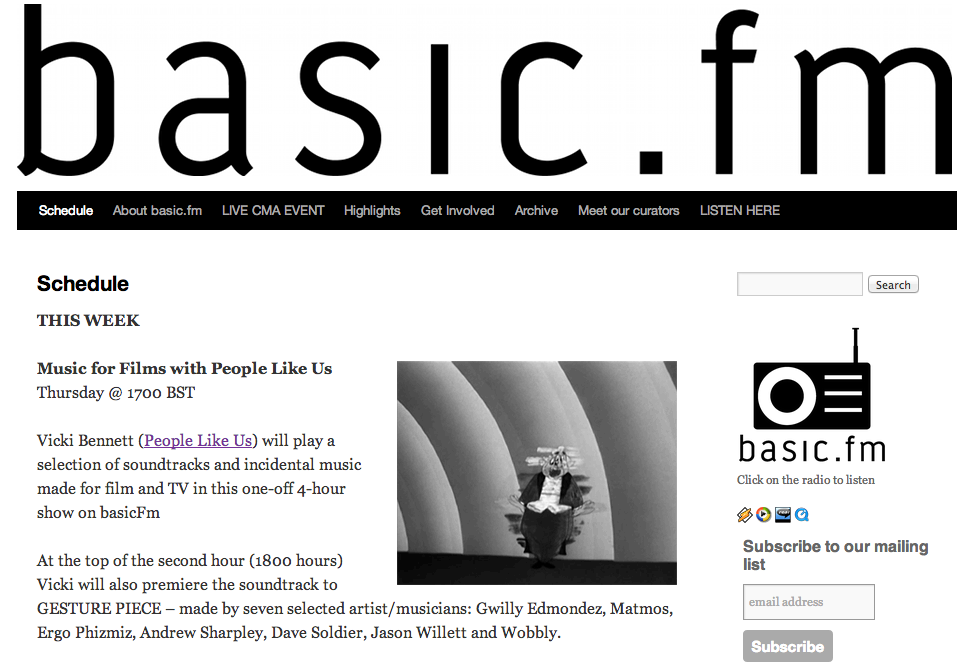
Music For The Fire now online at UbuWeb
The 2010 collaboration between People Like Us & Wobbly which became the CD “Music For The Fire” is now available for mp3 download at UbuWeb.
The fruit of many years of work, this album began as People Like Us & Wobbly collected and collaged their way through various depictions of misfired communications and heartbreak sourced from popular culture for a series of live improvisations. Music For The Fire is a plunderphonic concept album depicting the lifespan of a relationship, as told through samples of hundreds of different songs and voices who had no idea they were all telling the same story until they were all spliced together.
http://www.ubu.com/sound/plu_fire.html
It is still available for purchase in CD and FLAC form at Illegal Art.
GESTURE PIECE – a film with a score by 7 artists
A film by Vicki Bennett [2013]
Soundtracks by :
Andrew Sharpley [00:06] | Matmos [01:02] | Wobbly [05:08] | Gwilly Edmondez [07:48] | Dave Soldier [09:38] | Jason Willett [11:02] | Ergo Phizmiz [13:23]
Gwilly Edmondez, Matmos, Ergo Phizmiz, Andrew Sharpley, Dave Soldier, Jason Willett and Wobbly each composed a score for a chapter of GESTURE PIECE, without any knowledge of who else was collaborating on the project or what the rest of the film would look or sound like.
The completed film stitches back together the seven chapters with their individual soundtracks, creating new connections between apparently unrelated film sequences. The result is a fascinating and witty reinterpretation of familiar film footage, with scenes arranged in surprising and often very funny combinations.
The title of “Gesture Piece” is partly self-explanatory – within human communication it is part of our hard circuitry that for instance we use hand gestures to articulate our speech, which is essentially graphically describing/enforcing audio or spoken discourse. Even when spoken language is not present, a whole series of hand and facial gestures are available to us to communicate expressions. By making a film that both contains human gestures (hands, facial, movement) as well as gestures made by natural and mechanical occurrences we are setting up the conditions for a dialogue between the graphical elements on the films and the improvisers, both with the film as well as with each other.
Background info
Gesture Piece @Tyneside Cinema
Review in This Is Tomorrow Magazine
Interview with a-n Magazine
Interview with SyncTank
Interview with Dominic Smith
Screenings
October 2014 – Other Cinema, San Francisco
October 2013 – Gesture Piece at High Zero Festival, Baltimore
Click on thumbnails to download stills: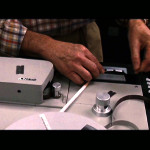

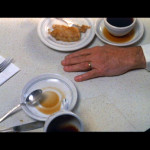
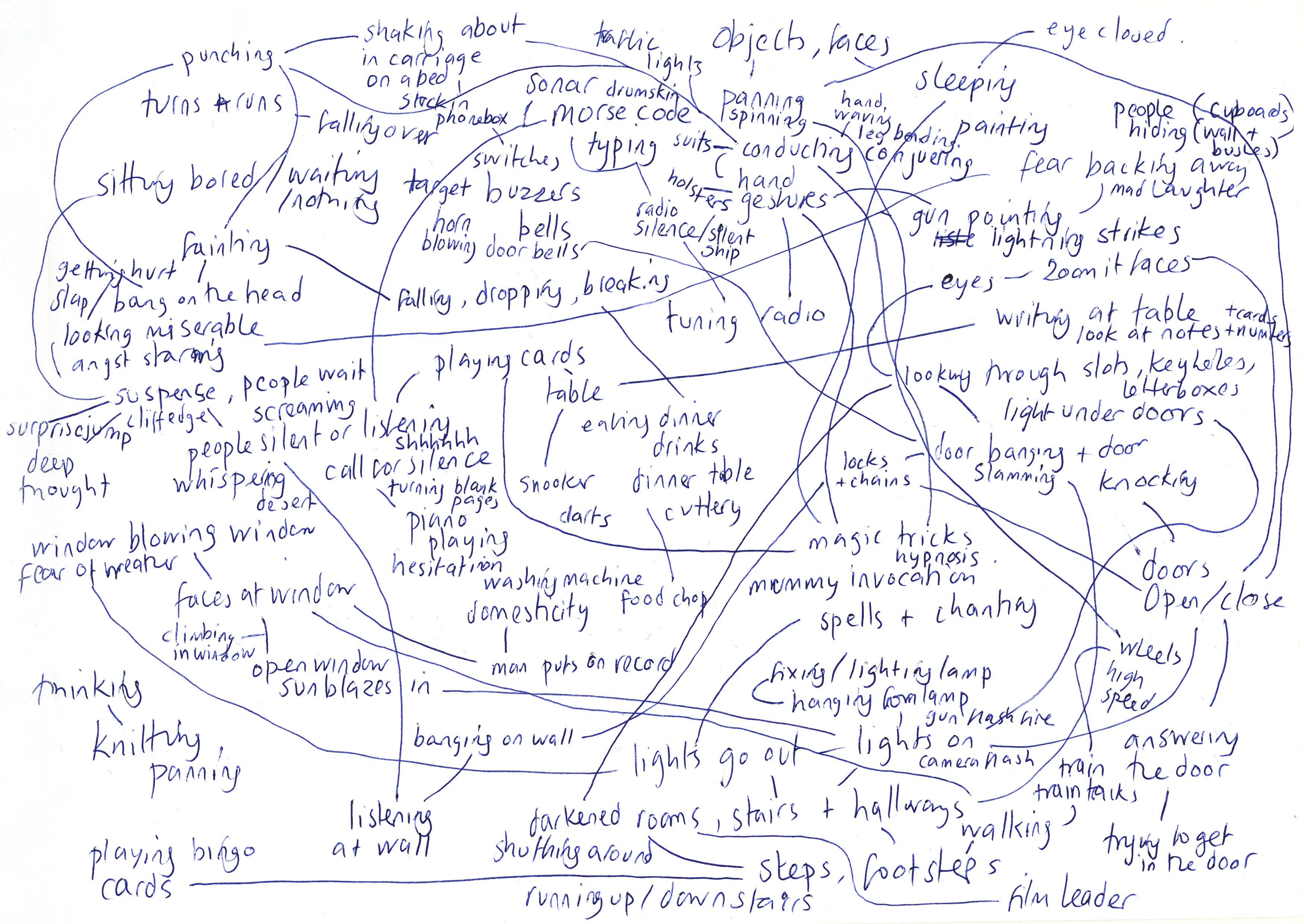
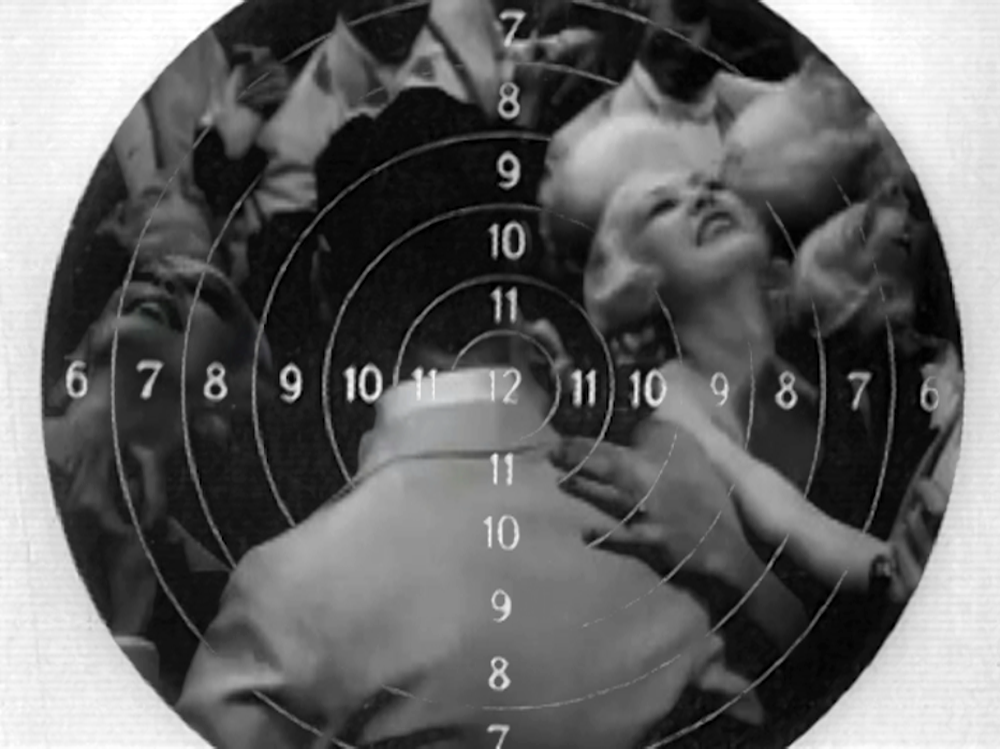
Gesture Piece has a sister project, Notations – a film created for live performance by selected improvising musicians and artists. When these two projects began, they shared the same umbrella name of Gesture Piece (the live performance was tested at Tectonics Festival in Reykjavik and Tel Aviv), but as the work developed it felt natural to separate them out into different names as they became two unique and separate entities.
Collateral Damage in The Wire Magazine, March 2012
Vicki Bennett has written the Collateral Damage page for the March edition of The Wire magazine.
http://thewire.co.uk/issues/337/
It is also available to read in The Wire’s online archive:
http://thewire.co.uk/in-writing/essays/collateral-damage_vicki-bennett

Vicki will also speak at Off The Page in Whitstable on 25th February 2012 as part of a panel based around the same column.
http://www.peoplelikeus.org/2012/off_the_page_the_wire_sound_and_music.html
Collateral Damage: Vicki Bennett
February 2012
In the early 2000s, increased bandwidth allowed recombinant artists to enter the gift economy. It’s a freedom we should defend at all costs, argues Vicki Bennett aka People Like Us
In 1999 I bought my first fast computer – and although it was dying to do speedy things, I was on dial-up, reduced to a crawl when it came to information retrieval. Logged into file sharing communities, I’d sit in the chat and watch people posting files that would take me a day to download, so I’d just read about them. Then I’d go to the WFMU website and try to stream the station and just get blurts and gaping silences. Then I’d visit archive.org and look at all the wonderful synopses for Rick Prelinger’s films, which were too large to access. It wasn’t long, however, before affordable broadband reached my area of London. Then everything changed. Forever.
The biggest improvement that broadband has brought me is access to previously inaccessible content, which I can then work with as raw material. In 2000, Internet Archive founder Brewster Kahle asked Prelinger to share his films online, for free. Although Prelinger was initially wary of this suggestion, he did so. By making these films available in good quality and continuing to sell the same footage in high quality, not only did he advertise his commercial archive, but also this generous act had a revolutionary effect on artists like myself who utilise already existing footage to make new works. Before this, I’d approached regional and national archives and either found a total lack of interest in collaboration, or a bigger interest but lack of manpower to liaise in realising the project. The advent of broadband made it possible to share on a massive scale. It changed my life.
With more people producing and distributing for themselves, the dynamic has changed and the focus shifted away from the middleman towards the producer. Since 2000, albums I’ve made with Ergo Phizmiz and Wobbly were created remotely, as a result of being in different parts of the world, through ftping multitracks. Many are surprised to hear that such methods could be successful, but working alone on site, and in collaboration online, can be a winning combination. Once completed, it can be shared online. If you work with the right people you’ll reach thousands of listeners. In turn, some of those listeners will be working in areas where they can offer concerts, commissions, or play you on their radio show. This is called the Gift Economy.
Audio content both for People Like Us and my radio show has mainly been sourced online. This heightened access increased my musical knowledge massively, feeding into my creative process, the palette increasing in size and colour. Access to and hosting by curated servers like UbuWeb has given a wider context to my work, where I’ve found aesthetic similarities to genres that in turn inform my practice. As well as curated music servers, there are now thousands of dedicated, knowledgeable music blogs. A web search for an obscure artist heard on the radio will take you to a blog telling you all about them, sharing out-of-print material, with tags linking to related areas. An adjacent column will have links to 25 other websites and radio stations with similar interests. There then follows a wonderful odyssey into hidden and often forgotten sonic worlds. This is very different from looking in an Oxfam record bin.
As well as being able to access specialist audio and moving images, broadband also made it possible to hear radio on a worldwide scale. Although analogue radio has long served the world over certain wavelengths for larger radio networks, it was an amazing experience to hear smaller radio stations like WFMU, where, as a result, I have been a DJ since 2003. WFMU archives its past shows forever, making them available for free listening. When Googling a little-known artist, the chances are the results will include a WFMU playlist. This helped make the local New Jersey radio station a global concern – and now, more people listen online than through radio receivers.
With this enhanced access in the past decade, one is far more likely to hear more less often than less more often. This shifts the way one listens, as the process becomes more like a ‘one-off’ experience of something that is ‘live’ or ‘unrepeatable’, almost like it was before the age of recording. Cassette sharing has been replaced with links and playlists. The physical experience of holding something as a treasured possession is lost, or it would be if you’d put your laptop or iPhone down. The loss of the artefact in favour of info.txt and jpegs is unfortunate; however, I recall many hours spent in record stores only looking at the covers.
In Klaus Maeck’s 1983 film Decoder, Genesis P-Orridge states, “Information is like a bank. Our job is to rob that bank.” These were prophetic words. Freedom of the internet is under threat – over access to and ownership of information. Although I don’t see sharing and creatively transforming information and content as plundering, I do believe the ‘banks’ have the potential to lock up a lot that should rightfully be ours. When Megaupload was recently shut down for facilitating copyright infringement and money laundering, approximately 150 million users instantly lost access to their files. Carpathia and Cogent, Megaupload’s hosting companies, have been told by the US authorities that they are free to delete the content, but unlike the US government’s approach of throwing out the baby with the bathwater, Carpathia has put together a website (megaretrieval.com) with the Electronic Frontier Foundation (EFF) so that affected users can assess the scope of the issue and try to retrieve their data. My focus here is not on the legal aspect of this case, but on how further damage occurs when a heavy-handed approach is taken in dealing with such a situation – millions of users were innocently implicated in this case and the collateral damage is immense.
We may be at the stage where many people don’t even wish to download, and are just happy to listen to Spotify or Last.fm, and much future content will only be on servers, with smaller domestic hard drives. While advocating the sharing ethic, I’m wary of ‘the cloud’ – servers looking after everything for you. Megaupload was a ‘cloud’ – it remains to be seen what happens to users and their data when things go wrong. Intellectual property is a complicated issue with many grey areas, which need to be assessed on an individual basis. If there is the opportunity to throw out the grey with the black, this is often done. My main concern over the cloud is that this ‘automatic and effortless’ experience of access may be improved upon by eventually narrowing down results to only mainstream or sponsored content; in the worst cases, people may find themselves simply shut out.
I can’t over-emphasise how much broadband has improved my life, and although I worry about the control of this ‘free’ space, I remain optimistic of seeing blue sky between the clouds. At present, I am curating and programming Radio Boredcast, a month long online radio station for the AV Festival. All content and submissions reached me by way of that modem sitting next to the telephone socket, which then flew across the living room into my computer. I don’t know how that happens, but I’m glad it does.
Wobbly on DO or DIY
Wednesday 13th July 2011 on DO or DIY with People Like Us
Wobbly
On this week’s DO or DIY, it’s the turn of Jon Leidecker aka Wobbly to do a 25 minute guest DJ mix.
Since 1990 Jon Leidecker has performed appropriative collage music under the psuedonym Wobbly, aiming for extended narratives spun from spontaneous yet coherent multi-sample polyphony. This Variations podcast series at Radio Web MACBA Jon Leidecker reconstructs the history of sound appropriationism by looking at examples from 20th century composition, popular art and commercial media, and the convergence of all these trends today.
http://detritus.net/wobbly/
http://rwm.macba.cat/en/variations_tag/
